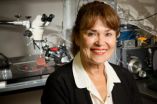(Press-News.org) CHAMPAIGN, lll. — The rhythm of life is driven by the cycles of day and night, and most organisms carry in their cells a common, (roughly) 24-hour beat. In animals, this rhythm emerges from a tiny brain structure called the suprachiasmatic nucleus (SCN) in the hypothalamus. Take it out of the brain and keep it alive in a lab dish and this "brain clock" will keep on ticking, ramping up or gearing down production of certain proteins at specific times of the day, day after day.
A new study reveals that the brain clock itself is driven, in part, by metabolism, the production and flow of chemical energy in cells. The researchers focused primarily on a phenomenon known as "redox" in tissues of the SCN from the brains of rats and mice.
Redox represents the energy changes of cellular metabolism (usually through the transfer of electrons). When a molecule gains one or more electrons, scientists call it a reduction; when it loses electrons, they say it is oxidized. These redox reactions, the researchers found, oscillate on a 24-hour cycle in the brain clock, and literally open and close channels of communication in brain cells.
The researchers report their findings in the journal Science, which also wrote a Perspective on the research.
"The language of the brain is electrical; it determines what kind of signals one part of the brain sends to the other cells in its tissue, as well as the other parts of the brain nearby," said University of Illinois cell and developmental biology professor Martha Gillette, who led the study. "The fundamental discovery here is that there is an intrinsic oscillation in metabolism in the clock region of the brain that takes place without external intervention. And this change in metabolism determines the excitable state of that part of the brain."
SIDEBAR: Want to Know More?
The new findings alter basic assumptions about how the brain works, Gillette said.
"Basically, the idea has always been that metabolism is serving brain function. What we're showing is metabolism is part of brain function," she said. "Our study implies that changes in cellular metabolic state could be a cause, rather than a result, of neuronal activity."
INFORMATION:
The study team also included graduate student Yanxun Yu, postdoctoral researcher Gubbi Govindaiah, graduate student Xiaoying Ye, graduate student Liana Artinian, electrical and computer engineering professor Todd Coleman, chemistry professor Jonathan Sweedler and pharmacology professor Charles Cox. Gillette, Govindaiah, Ye, Sweedler and Cox also are affiliates of the Beckman Institute at Illinois.
Metabolism in the brain fluctuates with circadian rhythm
2012-08-29
ELSE PRESS RELEASES FROM THIS DATE:
Mayo study: Exercise can help cancer patients, but few oncologists suggest it
2012-08-29
ROCHESTER, Minn. -- Numerous studies have shown the powerful effect that exercise can have on cancer care and recovery. For patients who have gone through breast or colon cancer treatment, regular exercise has been found to reduce recurrence of the disease by up to 50 percent. But many cancer patients are reluctant to exercise, and few discuss it with their oncologists, according to a Mayo Clinic study published in the Journal of Pain and Symptom Management.
"As doctors, we often tell patients that exercise is important, but to this point, nobody had studied what patients ...
Why retire later?
2012-08-29
ANN ARBOR, Mich.---What if every U.S. worker got an automatic 10 percent pay raise at age 55? According to a new University of Michigan study, most people would work quite a bit longer to enjoy the extra income before they retired.
By eliminating social security payroll taxes starting when workers are 55-years old, the study shows that take-home pay would jump by 10.6 percent and they would work 1.5 years longer on average, paying more income taxes and helping to reduce the Federal deficit.
"People are living longer, healthier lives, and so far have opted to take most ...
Evaluate children's stress after natural disasters
2012-08-29
CORAL GABLES, FL (August 28, 2012) -- As Hurricane Isaac nears the Gulf Coast, one may wonder what the impact of natural disasters are on children. Who is most at risk for persistent stress reactions? How can such youth be identified and assisted in the aftermath of a destructive storm?
Dr. Annette M. La Greca, a professor of psychology and pediatrics at the University of Miami, and her colleagues, have been studying children's disaster reactions following Hurricanes Andrew (1992), Charley (2004) and Ike (2008). Recent findings from Hurricane Ike shed light on these questions ...
Kindergarten readiness: Are shy kids at an academic disadvantage?
2012-08-29
CORAL GABLES, FL (August 28, 2012)—Parents of young children hope for a successful kindergarten experience that will set their youngsters on the right path of their educational journey. Some worry about their kids not adapting to the school environment, particularly when the children are talkative and overactive. Yet, a new study by the University of Miami (UM) shows that overly shy preschool children are at greater academic risk than their chatty and boisterous peers.
The study is one of the first to follow the social and academic progress of children throughout the preschool ...
Pretend play may not be as crucial to child development as believed, new study shows
2012-08-29
Pretend play can be fun for preschool children, but a new University of Virginia study, published in a recent online edition of the journal Psychological Bulletin, finds that it is not as crucial to a child's development as currently believed. Pretend play is any play a child engages in, alone, with playmates, or with adults, that involves uses of the imagination to create a fantasy world or situation, such as making toy cars go "vrrooooom" or making dolls talk.
Based on a number of key studies over four decades, pretend play is widely considered by psychologists – and ...
URMC researchers connect new genetic signature to leukemia
2012-08-29
University of Rochester Medical Center scientists believe they are the first to identify genes that underlie the growth of primitive leukemia stem cells, and then to use the new genetic signature to identify currently available drugs that selectively target the rogue cells.
Although it is too early to attach significance to the drug candidates, two possible matches popped up: A drug in development for breast cancer (not approved by the Food and Drug Administration), and another experimental agent that, coincidentally, had been identified earlier by a URMC laboratory as ...
Diagnosis often missed for Hispanic children with developmental delay, autism
2012-08-29
This press release is available in Spanish.(SACRAMENTO, Calif.) — Hispanic children often have undiagnosed developmental delays and large numbers of both Hispanic and non-Hispanic children who first were thought to have developmental delay actually had autism, researchers affiliated with the UC Davis MIND Institute have found.
The study, one of the largest to date to compare development in Hispanic and non-Hispanic children, is published in the journal Autism. The results lead the study authors to recommend increased public health efforts to improve awareness, especially ...
Protein found to regulate red blood cell size and number
2012-08-29
CAMBRIDGE, Mass. (August 28, 2012) –The adult human circulatory system contains between 20 and 30 trillion red blood cells (RBCs), the precise size and number of which can vary from person to person. Some people may have fewer, but larger RBCs, while others may have a larger number of smaller RBCs. Although these differences in size and number may seem inconsequential, they raise an important question: Just what controls these characteristics of RBCs?
This question is particularly relevant for the roughly one-quarter of the population that suffers from anemia, which ...
Beliefs drive investors more than preferences, study finds
2012-08-29
COLUMBUS, Ohio - If experts thought they knew anything about individual investors, it was this: their emotions lead them to sell winning stocks too soon and hold on to losers too long.
But new research casts doubt on this widely held theory that individual investors' decisions are driven mainly by their feelings toward losses and gains. In an innovative study, researchers found evidence that individual investors' decisions are primarily motivated by their beliefs about a stock's future.
"The story is not about whether an investor hates losing or loves gains – it's not ...
Magnetic vortex reveals key to spintronic speed limit
2012-08-29
UPTON,NY -- The evolution of digital electronics is a story of miniaturization - each generation of circuitry requires less space and energy to perform the same tasks. But even as high-speed processors move into handheld smart phones, current data storage technology has a functional limit: magnetically stored digital information becomes unstable when too tightly packed. The answer to maintaining the breath-taking pace of our ongoing computer revolution may be the denser, faster, and smarter technology of spintronics.
Spintronic devices use electron spin, a subtle quantum ...

